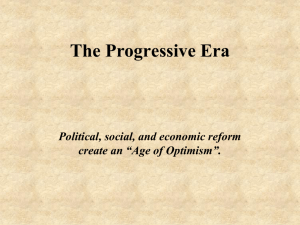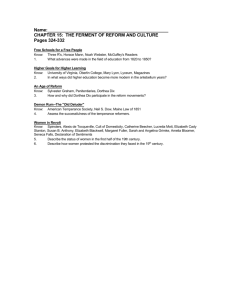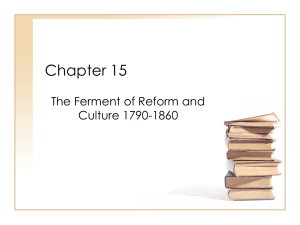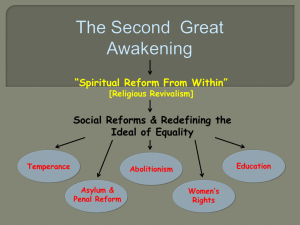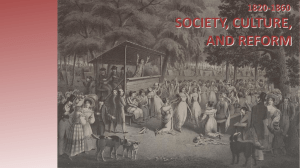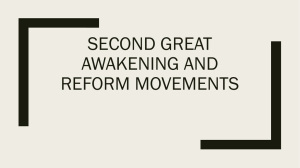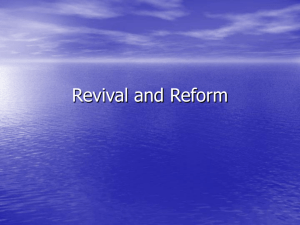Industrial Life and Moral Reform
advertisement
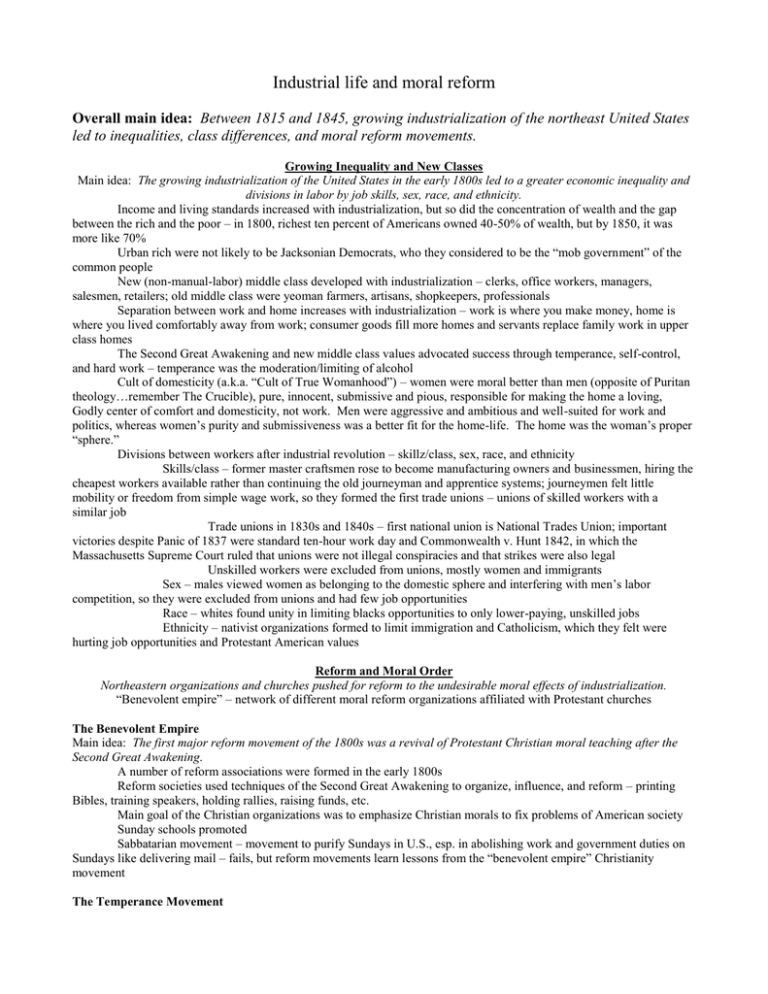
Industrial life and moral reform Overall main idea: Between 1815 and 1845, growing industrialization of the northeast United States led to inequalities, class differences, and moral reform movements. Growing Inequality and New Classes Main idea: The growing industrialization of the United States in the early 1800s led to a greater economic inequality and divisions in labor by job skills, sex, race, and ethnicity. Income and living standards increased with industrialization, but so did the concentration of wealth and the gap between the rich and the poor – in 1800, richest ten percent of Americans owned 40-50% of wealth, but by 1850, it was more like 70% Urban rich were not likely to be Jacksonian Democrats, who they considered to be the “mob government” of the common people New (non-manual-labor) middle class developed with industrialization – clerks, office workers, managers, salesmen, retailers; old middle class were yeoman farmers, artisans, shopkeepers, professionals Separation between work and home increases with industrialization – work is where you make money, home is where you lived comfortably away from work; consumer goods fill more homes and servants replace family work in upper class homes The Second Great Awakening and new middle class values advocated success through temperance, self-control, and hard work – temperance was the moderation/limiting of alcohol Cult of domesticity (a.k.a. “Cult of True Womanhood”) – women were moral better than men (opposite of Puritan theology…remember The Crucible), pure, innocent, submissive and pious, responsible for making the home a loving, Godly center of comfort and domesticity, not work. Men were aggressive and ambitious and well-suited for work and politics, whereas women’s purity and submissiveness was a better fit for the home-life. The home was the woman’s proper “sphere.” Divisions between workers after industrial revolution – skillz/class, sex, race, and ethnicity Skills/class – former master craftsmen rose to become manufacturing owners and businessmen, hiring the cheapest workers available rather than continuing the old journeyman and apprentice systems; journeymen felt little mobility or freedom from simple wage work, so they formed the first trade unions – unions of skilled workers with a similar job Trade unions in 1830s and 1840s – first national union is National Trades Union; important victories despite Panic of 1837 were standard ten-hour work day and Commonwealth v. Hunt 1842, in which the Massachusetts Supreme Court ruled that unions were not illegal conspiracies and that strikes were also legal Unskilled workers were excluded from unions, mostly women and immigrants Sex – males viewed women as belonging to the domestic sphere and interfering with men’s labor competition, so they were excluded from unions and had few job opportunities Race – whites found unity in limiting blacks opportunities to only lower-paying, unskilled jobs Ethnicity – nativist organizations formed to limit immigration and Catholicism, which they felt were hurting job opportunities and Protestant American values Reform and Moral Order Northeastern organizations and churches pushed for reform to the undesirable moral effects of industrialization. “Benevolent empire” – network of different moral reform organizations affiliated with Protestant churches The Benevolent Empire Main idea: The first major reform movement of the 1800s was a revival of Protestant Christian moral teaching after the Second Great Awakening. A number of reform associations were formed in the early 1800s Reform societies used techniques of the Second Great Awakening to organize, influence, and reform – printing Bibles, training speakers, holding rallies, raising funds, etc. Main goal of the Christian organizations was to emphasize Christian morals to fix problems of American society Sunday schools promoted Sabbatarian movement – movement to purify Sundays in U.S., esp. in abolishing work and government duties on Sundays like delivering mail – fails, but reform movements learn lessons from the “benevolent empire” Christianity movement The Temperance Movement Main idea: The temperance movement, taking lessons from the “benevolent empire,” effectively reduced American consumption of alcohol in an attempt to reform moral society. Temperance – the reduction, limiting, or moderation of alcohol…not necessarily the prohibition of it Temperance advocates thought that self-control in regards to alcohol would also help in other areas of moral and economic life American Temperance Society formed in Boston in 1826 American alcohol consumption in 1830 – 7.1 gallons per year for ages 14 and up (highest all time); alcohol consumption in 1845 – less than 2 gallons per year; before 1840s, alcohol was a part of almost all social life, especially among lower classes Massive propaganda campaign, preachers, tracts, revivals and rallies, pledges, pressure by women, campaigns made inroads into working class neighborhoods Temperance advocates connected alcohol consumption and lack of self-control with the economic depression after the Panic of 1837 Some prohibition laws passed, but quickly overturned by anti-temperance groups; still, temperance movement was successful in lowering alcohol consumption dramatically Women’s Roles in Reform Main idea: The role of some women in the reform movement shifted from the benevolent, submissive caretaker to the active, aggressive moral critic, a forerunner of later feminism. “Social mother” position of women in the Christian moral revival and the temperance movement changes to a more active role, even in politics; examples: campaign against prostitution and adultery (American Female Moral Reform Society helped pass laws against the two); critique of poverty in society as a result of men’s greed and selfishness, rather than simply trying to help them submissively, without criticism Backlash Against Benevolence Main idea: Some Americans criticized the moral reformers as Northeastern middle and upper-class elites trying to control and impose their values on the rest of the country. Those uprooted by social effects of industrialization and economic consequences of the depression were not so thrilled to be preached to by wealthier outsiders; resented aggressiveness of women in reform and clung to community church values Biggest unified response is the Church of Jesus Christ of Latter-day Saints, a.k.a. the Mormon Church – founded by Joseph Smith in 1830; Smith received revelations from God that he wrote into the Book of Mormon; in relation to the moral reform issues, Mormonism gave complete authority to men and salvation to women through submission; the church fostered a community that benefited all in which the members could depend, rather than be controlled or preached to about individual pursuits Overall main idea: Between 1815 and 1845, growing industrialization of the northeast United States led to inequalities, class differences, and moral reform movements.
